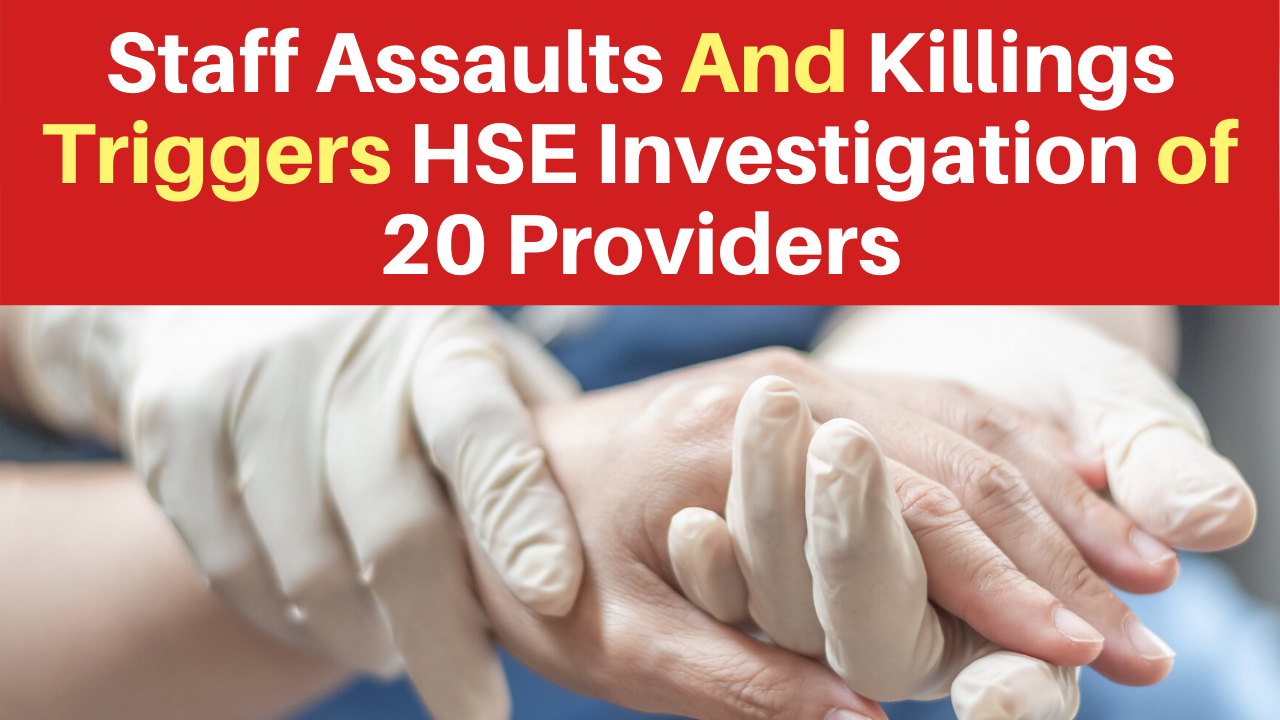Staff Assaults And Killings Triggers HSE Investigation of 20 Providers
The above is the headline of an exclusive article in HSJ Magazine that was published on the 18th December 2019 by Matt Discombe.
In that article Mr Discombe highlights that the HSE have carried out inspections at 20 health and care providers after three health workers in the last five years have died after being assaulted by patients.
The article goes on to say that the HSE are inspecting how these care providers are managing risks to their staff from violence and aggression, as well as looking into musculoskeletal disorders.
“Significant Contraventions of The Law”
The HSE inspection at Leeds Community Healthcare Foundation Trust had “observed significant contraventions of the law” during an audit in August and September.
The HSE’s inspection found “evidence to indicate the trust is not doing all that is reasonably practicable” to manage violence and aggression and musculoskeletal disorders, which breached two sections of the Health and Safety at Work Act 1974.
The Inspection Also Found:
# The trust’s policies for violence and aggression, lone workers and safe moving and handling “do not identify high risk locations, tasks or roles”;
# There was “no indication” in the violence and aggression policy “of what type of risk assessment must be produced and when”;
# Evidence that security or environmental risk assessments “are not consistently carried out”;
# Procedures for responding to panic alarms are “inconsistent” and there was “no evidence to confirm any procedures are routinely tested to ensure they work”; and
# Inspectors also found the trust had three breaches of the Management of Health and Safety at Work Regulations 1999, which require employers to have sufficient risk assessments in place and take “all reasonable steps” to comply with the law.
HSJ has asked the HSE to identify the other 19 care providers which are included in this inspection programme and for findings from other inspections it has carried out, but it has not yet provided these.
You can read the full article in HSJ here (but you need to subscribe for a Free Account to do so) – https://www.hsj.co.uk/workforce/exclusive-staff-assaults-and-killings-spark-investigation-of-20-providers/7026541.article
Physical Restraint, Manual Handling, Lone Working and Musculoskeletal Disorders
As many of you are aware, physical restraint (also known as physical intervention, mva or pmva in healthcare settings) is a manual handling activity so the activity must include a manual handling risk assessment.
Some restraint systems also (despite the evidence against doing so), condone staff restraining patients/service users on their own, and any single person restraint is a lone working activity so a lone working risk assessment must be done (which is actually totally unnecessary because staff should not be restraining on their own anyway).
And, as any system of restraint involves staff ‘manually handling a patient/service user’, the risk of any musculoskeletal disorders must be suitable and sufficiently controlled also.
All of these are legal requirements.
These are some of the things we have been doing for years, which makes our restraint system legally defensible.
The New Physical Intervention Accreditation Scheme
As many of you are aware, there is new PI accreditation scheme coming in in April 2020 and if you wish to continue delivering PI training to a NHS trust with a mental health unit you need to have (or be working towards) the new accreditation standards.
This has been made a condition of contract by NHS England.
The problem for me with the new pi accreditation standards is although they state that risk assessments should be in place, you cannot actually achieve the accreditation (even if the risk assessment requires it) if you use or teach certain techniques.
Therefore, what training providers and commissioners of training in healthcare need to do (if they need the accreditation to ensure that they keep the business) is remove the use of certain techniques (and possibly even mechanical restraints) from their syllabus and operational portfolio, or not disclose the fact that they are using them.
That means that they are willing to comply with something that contravenes the law (in cases where a risk assessment requires the use of those specific techniques or equipment) for financial gain over staff and patient/service user safety.
And that isn’t something I am willing to compromise on.
I have made my position on this clear and if you want to find out more about why we will not be adopting these new standards you can do so here:
1: Why You Should Consider Not Training With Us [Video] – https://nfps.info/why-you-should-consider-not-training-with-us-video/,
2: Is the New PI Accreditation Worth It, or Are We Putting Profits Before Safety? – https://nfps.info/is-the-new-pi-accreditation-worth-it-or-are-we-putting-profits-before-safety-video/
3: The Reasons Behind Why NFPS Ltd Will Not Be Adopting The BILD/RRN/UKAS PI Accreditation Scheme [Video] – https://nfps.info/the-reasons-behind-why-nfps-ltd-will-not-be-adopting-the-bild-rrn-ukas-pi-accreditation-scheme-video/
Best Regards
Mark Dawes
#training

